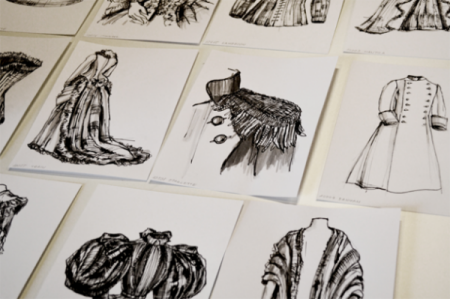Visual thesaurus for online fashion heritage
Fans of fashion heritage have long been able to find collections from Dutch textile and fashion museums online at the Dutch website, Modemuze.nl. Inspired by this platform, MoMu (Fashion Museum Antwerp) wanted to encourage its partners to use shared glossaries to also make its collections easier to search. After all, it’s this shared vocabulary that can serve as the first step towards publishing collection data as linked data, ensuring a richer experience for online visitors. As a member of this project’s steering committee, meemoo provided advice and contributed to the final edit of the user guide on CEST.
Challenge
What if you’re looking for images of ‘dungarees’ but the metadata for the collection in question only uses the American term ‘overalls’? This represents a common problem, which the use of shared glossaries when registering and publishing fashion collection data can resolve. It can allow you, for example, to also search for ‘overalls’ automatically when the search term ‘dungarees’ is entered. Linking the data across organisations and collections means you can even find examples of these items in different museums while you’re at it. This project links Flemish and Dutch fashion heritage terms for the same types of objects together online, resulting in richer search results.
Approach
We had an advisory role in this project, but we would like to highlight our partners’ activities, and especially the project supervised by Ykje Wildenborg at MoMu, because it demonstrates the possibilities of a visual thesaurus so well.

A first step in the project entailed looking at what already existed and seeing if it could be improved upon. A commonly used and internationally accepted thesaurus, the American Art & Architecture Thesaurus (AAT) was still lacking lots of object types and textile materials. Over 140 AAT concepts were therefore submitted to and processed by the Getty Research Institute via RKD (Netherlands Institute for Art History). These concepts are not terms in one specific language, but different terms or translations with the same meaning that have been compiled into a single concept using a unique number code.
Project partners were then supervised in cleaning up links for collections in a workshop before the proprietary set of terms was made available together with the existing fashion- and costume-related AAT concepts as the Visual Thesaurus for Fashion & Costume. David Ring also produced drawings for over 600 concepts, which are available on Wikimedia Commons. This thesaurus includes the drawings available in the SKOS (Simple Knowledge Organisation System) format, an exchange format for simplifying the publication and use of glossaries as data.
We drew up the practical guide ‘Link your terms’ ('Verbind je termen', only in Dutch), which we published on CEST, in collaboration with NDE (Digital Heritage Network). This guide goes further than just dealing with fashion heritage; it is aimed at organisations from all across the heritage field working in Adlib, but can also inspire people who work with different collection registration systems.
The implementation of the thesaurus in the Modemuze.nl platform allowed the effects to be shown in the professional field, so these organisations were made aware of the opportunities afforded by linked data.
If you would like to find out more about what this means for you as a fashion lover, then make sure you read the blog on modemuze.nl (in Dutch) where Ykje Wildenborg (MoMu) looks at linked terms in more detail, for example using the English term ‘Mary Janes’ for the shoes also known as ‘bar shoes’ or ‘doll shoes’.
Project partners
MoMu (Fashion Museum Antwerp) proposed this project and worked together with a steering group comprised of Modemuze, Netwerk Digitaal Erfgoed (Digital Heritage Network), meemoo and Rijksdienst voor het Cultureel Erfgoed (Cultural Heritage Agency of the Netherlands). The project was supported by Spinque, de Ghent University, Europeana Fashion and the RKD (Netherlands Institute for Art History).
The museums involved were: Amsterdam Museum, Rijksmuseum Amsterdam, Centraal Museum Utrecht, Het Loo Palace, Fries Museum, Museum Rotterdam, Kunstmuseum Den Haag, Art & History Museum, Royal Institute for Cultural Heritage, Modemuseum Hasselt.
